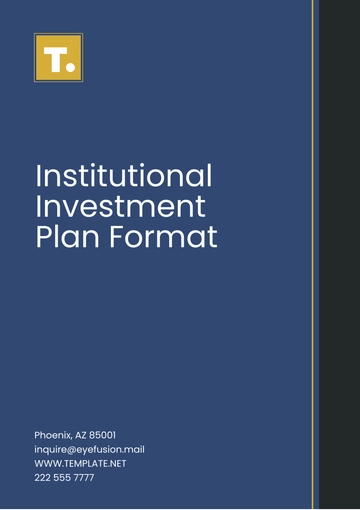Free Loan Outline Investment Plan

1. Executive Summary
This Loan Investment Plan outlines our strategy to invest in a diversified portfolio of small business and personal loans. Our objective is to achieve an average annual return of 8-10% over five years while maintaining a low default rate through rigorous credit assessments and risk management practices. This plan includes market insights, portfolio diversification strategies, and a roadmap to achieve sustainable returns for our stakeholders.
2. Market Analysis
The U.S. lending market for small business and consumer loans has shown consistent growth, with an increasing demand for accessible financing options post-pandemic. Data suggests a compound annual growth rate of 5% in loan demand over the next three years. Our target demographic includes small businesses and mid-to-high-income individuals with stable employment histories, primarily in metropolitan and suburban regions. Rising interest rates may increase loan yields but will require vigilant risk management to mitigate potential borrower defaults.
3. Investment Objectives
Return Target: Achieve a return of 8-10% annually.
Risk Tolerance: Moderate – focused on maintaining a default rate below 5%.
Investment Horizon: 5-year term with quarterly performance reviews.
Capital Preservation: Ensuring principal stability through conservative loan underwriting and diversified exposure.
4. Loan Types and Structures
Personal Loans: Fixed interest rates between 6-10%, 3-5 year terms, no collateral.
Small Business Loans: Secured with a 10-12% interest rate, terms ranging from 1-5 years, and collateral requirements based on loan amount and borrower’s business profile.
Mortgages: Adjustable rates, 15-30 year terms, focusing on borrowers with credit scores of 700+.
5. Risk Assessment
Credit Risk: Employ credit scoring models and comprehensive financial checks to maintain credit quality.
Interest Rate Risk: Monitor Federal Reserve actions closely to adjust loan terms accordingly, reducing the potential impact on portfolio performance.
Economic and Market Risk: Concentrate on industries that are resilient to recessions, such as essential services, and spread out loans to reduce the impact of economic downturns.
Mitigation Strategies: Regularly review and adjust loan covenants, implement early warning systems for missed payments, and allocate capital to diversified asset classes.
6. Investment Strategy
Loan Sourcing: Partnerships with reputable lenders and digital platforms specializing in small business and personal loans.
Underwriting Criteria: Require a minimum credit score of 650, verified income, and detailed business cash flow statements for small business loans.
Diversification: Limit exposure to a single borrower sector to 15% of the portfolio and restrict maximum loan size to $50,000 per individual borrower and $100,000 per business.
Management Approach: Quarterly reviews of loan performance metrics and borrower creditworthiness, with proactive adjustments to lending terms as needed.
7. Financial Projections
Year 1: Expected initial yield of 7% as the portfolio is built.
Year 2-3: Projected yields of 8-9% as loan volume increases and default rates stabilize.
Year 4-5: Achieve full yield target of 9-10%, with reinvestment of returns in higher-yielding loans and careful management of maturing assets.
Sample Income Statement:
Revenue from Loan Interest: $500,000
Loan Loss Provisions: $25,000
Net Income: $475,000
8. Funding Sources
Equity Investors: 60% of capital requirements are to be sourced from private equity investors targeting fixed income.
Debt Financing: 40% through a line of credit with a major bank, collateralized by the loan portfolio.
Reinvestment: Reinvest principal and interest payments from loans to generate compounding returns within the portfolio.
9. Monitoring and Reporting
Key Performance Indicators (KPIs): Loan yield, default rate, collection efficiency, and portfolio growth.
Reporting Frequency: Quarterly updates to investors, including comprehensive performance reviews, portfolio summaries, and risk management adjustments.
Performance Benchmarks: Compare returns against industry standards and adjust underwriting practices based on economic trends and borrower behavior.
10. Conclusion
This Loan Investment Plan presents a balanced approach to achieving sustainable returns in the lending sector by carefully targeting borrowers with strong repayment potential and maintaining a diversified portfolio across loan types. With a strong risk management framework and regular performance monitoring, we aim to deliver consistent returns while minimizing potential losses. Future initiatives include expanding into emerging markets and exploring technology-driven underwriting solutions to enhance portfolio quality.
- 100% Customizable, free editor
- Access 1 Million+ Templates, photo’s & graphics
- Download or share as a template
- Click and replace photos, graphics, text, backgrounds
- Resize, crop, AI write & more
- Access advanced editor
You may also like
- Finance Plan
- Construction Plan
- Sales Plan
- Development Plan
- Career Plan
- Budget Plan
- HR Plan
- Education Plan
- Transition Plan
- Work Plan
- Training Plan
- Communication Plan
- Operation Plan
- Health And Safety Plan
- Strategy Plan
- Professional Development Plan
- Advertising Plan
- Risk Management Plan
- Restaurant Plan
- School Plan
- Nursing Home Patient Care Plan
- Nursing Care Plan
- Plan Event
- Startup Plan
- Social Media Plan
- Staffing Plan
- Annual Plan
- Content Plan
- Payment Plan
- Implementation Plan
- Hotel Plan
- Workout Plan
- Accounting Plan
- Campaign Plan
- Essay Plan
- 30 60 90 Day Plan
- Research Plan
- Recruitment Plan
- 90 Day Plan
- Quarterly Plan
- Emergency Plan
- 5 Year Plan
- Gym Plan
- Personal Plan
- IT and Software Plan
- Treatment Plan
- Real Estate Plan
- Law Firm Plan
- Healthcare Plan
- Improvement Plan
- Media Plan
- 5 Year Business Plan
- Learning Plan
- Marketing Campaign Plan
- Travel Agency Plan
- Cleaning Services Plan
- Interior Design Plan
- Performance Plan
- PR Plan
- Birth Plan
- Life Plan
- SEO Plan
- Disaster Recovery Plan
- Continuity Plan
- Launch Plan
- Legal Plan
- Behavior Plan
- Performance Improvement Plan
- Salon Plan
- Security Plan
- Security Management Plan
- Employee Development Plan
- Quality Plan
- Service Improvement Plan
- Growth Plan
- Incident Response Plan
- Basketball Plan
- Emergency Action Plan
- Product Launch Plan
- Spa Plan
- Employee Training Plan
- Data Analysis Plan
- Employee Action Plan
- Territory Plan
- Audit Plan
- Classroom Plan
- Activity Plan
- Parenting Plan
- Care Plan
- Project Execution Plan
- Exercise Plan
- Internship Plan
- Software Development Plan
- Continuous Improvement Plan
- Leave Plan
- 90 Day Sales Plan
- Advertising Agency Plan
- Employee Transition Plan
- Smart Action Plan
- Workplace Safety Plan
- Behavior Change Plan
- Contingency Plan
- Continuity of Operations Plan
- Health Plan
- Quality Control Plan
- Self Plan
- Sports Development Plan
- Change Management Plan
- Ecommerce Plan
- Personal Financial Plan
- Process Improvement Plan
- 30-60-90 Day Sales Plan
- Crisis Management Plan
- Engagement Plan
- Execution Plan
- Pandemic Plan
- Quality Assurance Plan
- Service Continuity Plan
- Agile Project Plan
- Fundraising Plan
- Job Transition Plan
- Asset Maintenance Plan
- Maintenance Plan
- Software Test Plan
- Staff Training and Development Plan
- 3 Year Plan
- Brand Activation Plan
- Release Plan
- Resource Plan
- Risk Mitigation Plan
- Teacher Plan
- 30 60 90 Day Plan for New Manager
- Food Safety Plan
- Food Truck Plan
- Hiring Plan
- Quality Management Plan
- Wellness Plan
- Behavior Intervention Plan
- Bonus Plan
- Investment Plan
- Maternity Leave Plan
- Pandemic Response Plan
- Succession Planning
- Coaching Plan
- Configuration Management Plan
- Remote Work Plan
- Self Care Plan
- Teaching Plan
- 100-Day Plan
- HACCP Plan
- Student Plan
- Sustainability Plan
- 30 60 90 Day Plan for Interview
- Access Plan
- Site Specific Safety Plan





























